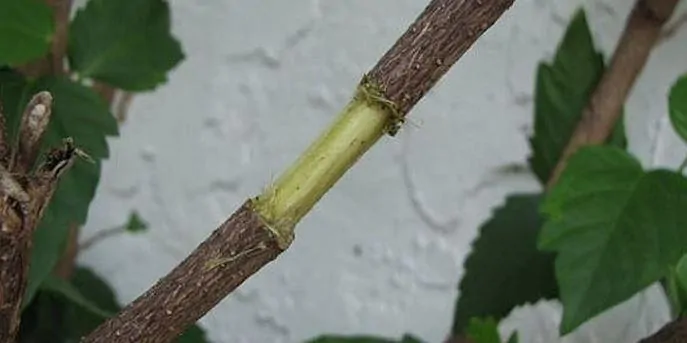Lime and Lemons are an essential part of our kitchen. Every kitchen gardener dreams of having one in his or her garden. Sometimes they bought a lemon or lime plant from any garden store. It is the easiest way but you will have to spend some money on that.
If you don’t want to spend money or wanna get it at the minimum cost. Then Air layering is the best option for you. It just requires some tools, soil, and a healthy Lemon mother plant. You can ask your friend or any neighbor who already has a lime or lemon plant. One single branch should not be a big sacrifice for anyone.
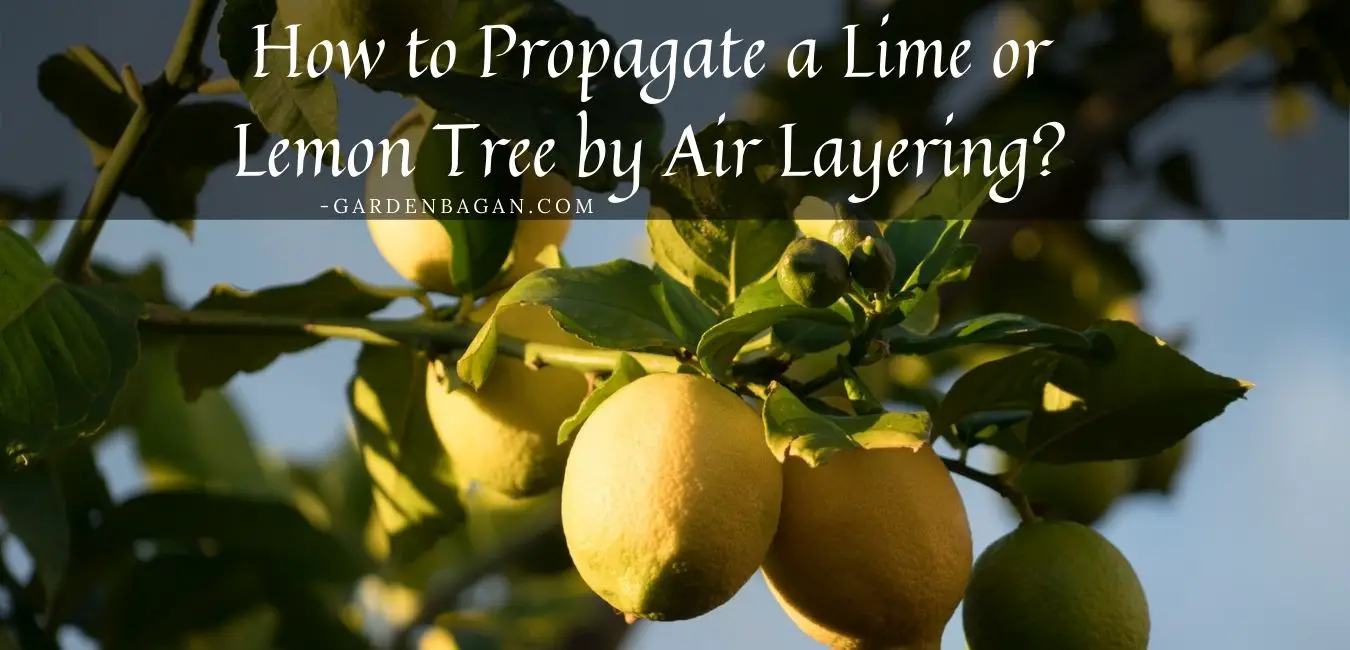
Check out my previous post: Pineapple Sage: How to Grow and care Salvia Elegans?
How long does air layering take to root?
An Air layering in the Lemon tree can take 8-15 weeks to develop a new root. Temperature, Moisture, and the variety of lemon Plant can change this timing.
Hard woody stems will take longer to root than semi-hardwood stems. The root will develop faster if the temperature and moisture are high. Long and direct exposure to sunlight can also speed up this process.
Flowers and fruits in the Air layering branch can slow down the rooting process. In Average, you have to wait for a minimum of 8-10 weeks to get a new lemon plant by Air layering.
How is air layering done in a lemon plant?
Air layering in the lemon plants is the most common way of propagating this citrus fruit. The process of air layering is very simple and quite easy. Still, you will require some knowledge and lots of patience.
Air Layering in a lemon plant starts with selecting a healthy semi-hardwood branch. The branch should be at least 8-10 inches long.
Next, you have to mark two circular cuts at the lower end of the branch. These cuts should be clean and at least 1-2 inches apart.
Carefully remove the bark between these two cuts. Clean white cambium should be visible after this process.
Put soil mix over this cut and cover it with a plastic sheet. Tie a knot at both ends so that water or air cannot enter.
Finally, wait for 8-10 weeks for the roots to develop. You can transplant a new lemon plant after a couple of weeks.
Also read: How to Care for a Gomphrena Plant?
Do you need rooting hormone for air layering?
Technically there is no need to use any rooting hormone for air layering. Only take care of the parent plant and use a nutrition reach media to layer the branch.
The use of Rooting hormone for air layering is an optional step. You can use any rooting hormone to make sure rooting happens. Otherwise, the broken bark will force the branch to develop a new healthy root system.
You can also use cinnamon powder over the cut before layering with soil. This is not a rooting hormone instead it will prevent any fungal growth.
How old the original tree should be before air layering a branch?
The parent lemon or lime plant must be 2-3 years old before air layering. It should be a mature, healthy, and well-rooted plant. Look out for any pest or insect attack before parent plant selection.
The parent or the original lemon tree must have 3 or more branches. This will ensure the survival of the plant even after you cut off one branch.
General selection of parent plants suggests choosing only those plants that have bear fruit in the previous two seasons. Fruiting is a sign of healthy growth. After a couple of fruiting seasons, the plant should be strong enough to support air layering.
What is the best time to Air Layer a Lemon Tree?
USDA suggests Spring to summer is the best time for air layering. You should start layering your lemon tree once the frost is over and the night temperature has increased over 18 degrees celsius.
The warm monsoon season is the best time to Air layer a Lemon tree. It would result even better if you finish layering a couple of weeks before the first rain of the season.
In Tropical and Subtropical climate, The month of August to October and Mid Feb to April is the ideal time for air layering in a Lime or Lemon tree.
Precautions with Air layering in Lemon or Lime Tree
- Never make cuts in the lemon branch with a dirty knife or blade. It will result in a fungal or even bacterial attack in the branch. Even if the parent plant survives the infestation the child or the layered branch will not yield enough.
- Don’t use clay for wrapping the cut. It will dry up quickly and become hard as cement. It will prevent any root growth. Instead, use a soft and nutritious mixture that can retain moisture for a long.
- Wrap and Tie the layering carefully. No water to enter or come out of this wrapping. The tight knots at both ends should hold the moisture inside. The water in the soil mix should not evaporate easily.
- Never open and water the air layering. Don’t do this even if the soil seems completely dry. Technically the plant doesn’t need this moisture for rooting. This moisture is only required to keep the soil soft and moist. The plant itself can support the root growth with an abundant supply of water.
- Finally, be careful during detaching the layered branch with the parent lemon tree. Never open the layer wrapping before cutting the branch. Tiny roots can easily break if the branched in jerked while the layering is open.
Tools and Materials Required for Air layering
Air layering is a simple procedure. You just need three basic gardening tools and little care to finish your job.
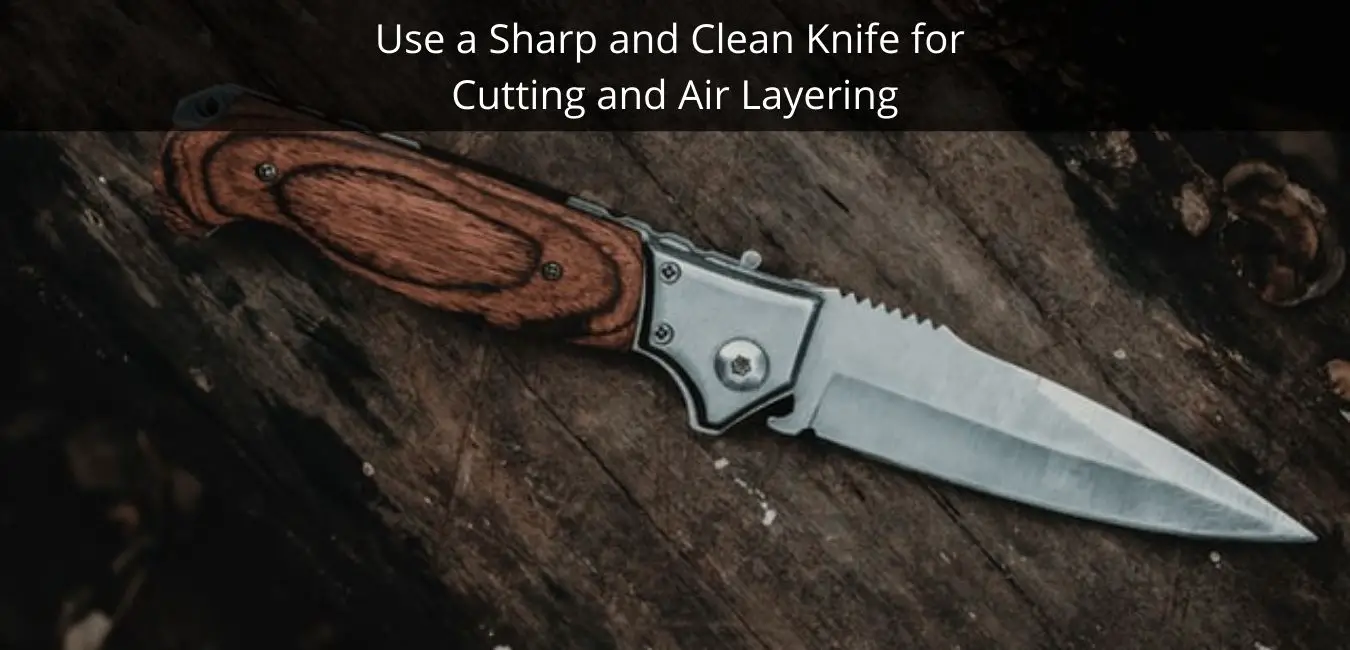
- A sharp knife or blade.
- A Plastic sheet to wrap the layering
- Some Threads or twist ties to tie strong knots. Use a Nilon or strong thick cotton treads for this purpose. The knot must remain intact for a couple of months, most probably 2 and a half months. Therefore, Use something that can easily survive heat, cold, sunlight, and regular watering.
Preparation for Air Layering
- Start with Sanitising the knife or blade you are using. Wipe the blade of the knife with rubbing alcohol or any disinfectant. It will ensure no infection can enter the cuttings.
- Make a soft dough with soil, sand, cocopeat, and compost. Use 50% compost or dry cow dung cake powder with 30% garden soil, 10% Clean sand, and 10% Cocopeat or peat moss. You can also use wood dust or leaf mold as an alternative. Mix 1 spoon full of fine wood ash or any fungicide to this soil mix. Add little water and make a soft even dough.
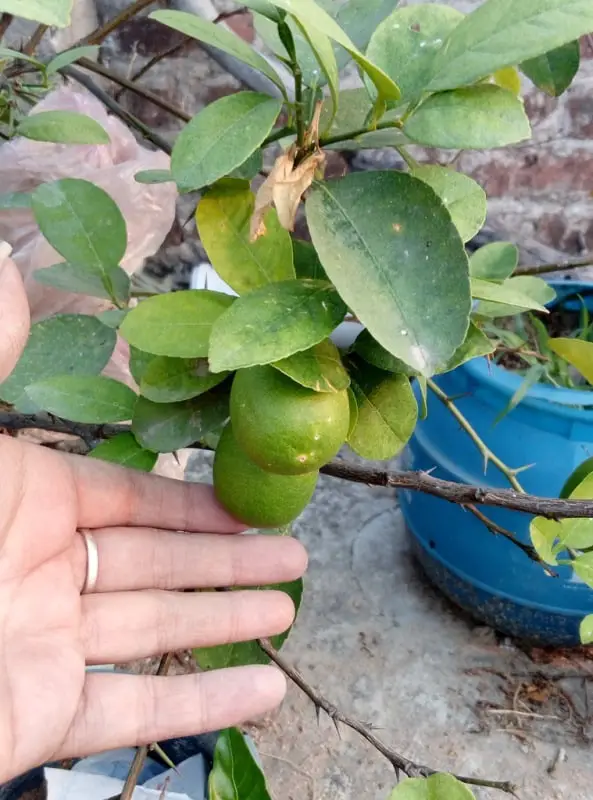
Also read: How to Grow Vinca from Cuttings: Periwinkle, Sadabhar Plants
Propagating a Lemon Tree by Air Layering
A New and clone lemon or lime plant can be easily prepared by Air layering a healthy parent plant. Layering in the lemon trees can be done in two ways.
- Layering a low ground touching branch. It is called Ground Layering
- Layering with soil mix and Wrapping the branches with plastic wrap. This is the true air layering technique.
Both these techniques have some pros and cons of their own.
The first method can only be applied to big lemon trees that have long widespread branches. In this method, you have to select the lower branches that are in contact with the soil.
You have to cover the branch at the point of contact with some soil. You can also scrap the skin to encourage faster root growth.
It is the easiest method of layering lemon trees. Although it can only be applied to big trees. Almost 7 out of 10 times this method is successful.
The second method is more technical. It requires knowledge, effort, and proper dedication. It can be applied to small container-grown plants. So it is the best commercial method of layering a lemon tree. This is a very successful method and you will succeed in every 8 out of 10 tries.
Next, we’ll see the proper Air layering method of a Lemon tree. Keep reading for details.
#1: Select a Parent Lemon plant and a healthy Branch
Choose a parent lemon or lime plant carefully. Different plants have different yield values. Some are sweet in taste while others are not. The scent, Taste, amount of Juice, Fruiting time, number of fruits, and growth rate vary from one variety to another. So you should choose a lemon variety according to your need.
Keep in mind new lemon plant will bear similar fruits and diseases to that of the parent lemon plant. They will be identical in nature.
You have to be more careful in selecting the branch for air layering after selecting the mother plant.
- Start with Choosing a clean branch. It should not have any kind of pest infestation. Try to avoid the branch with even minute fungal or bacterial infestation.
- Choose a 10-15 inch long semi-hardwood branch. It should be at least 1/2 inch thick in diameter. Thin branches will also develop roots but they are weak and take more time to mature and develop fruits.
- You can make multiple Air layering on a single branch. But it will require more precision and understanding of the plant’s health. Multiple air layering can be made at a minimum distance of 6 inches in a single branch.
- You have to make enough room to work on the branch. Clean the lower end of the branch by removing extra leaves and thin branches. Lemon and lime trees have sharp spines, so removing a few around the base can avoid any injury during working.
#2: Make two sharp Cut and Remove the Bark
Use a clean knife or blade to make two sharp circular cuts, each 1.5 to 2 inches apart from the other at the lower end of the selected branch.
The cut must be deep enough to touch the central hard cambium. Make another straight cut between these two cuts and slice open the bark.
#3: Clean The Cambium part Carefully
Make sure there is no contact left between the bark at the two end cuts. This is the critical part of air layering. Even a single strand of bark can fail your entire effort.
Scrap the cambium surface carefully to remove any skin or bark trace. Only clean white cambium must be visible after this process.
Make sure the cut is clean from all sides.
#4: Cover the Open Cut with Soil Mix Dough
We have already prepared our soil mix dough, if not read again. Make a smooth ball from this dough.
The ball should be big enough to cover the open cut at the lemon branch. Generally, a 2-3 inch dough ball will do the job. You don’t have to measure it with scale. just make it like a golf ball and it should fit in your hand.
Break the soil mix the dough ball in half and cover the cutting area with it. Keep the dough thicker at the uppercut. New roots will develop here.
#5: Wrap The Layering With Clean plastic Sheet
Cut a 4-inch piece of clean plastic sheet. The sheet should cover both ends of layering. Gently Wrap the layered branch with this plastic sheet. I prefer a transparent plastic sheet but a dark one works faster.
A transparent plastic sheet will allow us to easily observe the root growth.
#6: Tie both the ends of the Wrapping
Tie a knot at both ends of layered wrapping. Always use strong thick cotton or nylon thread to tie these knots. The knot must be strong enough to hold the soil mix for a couple of months.
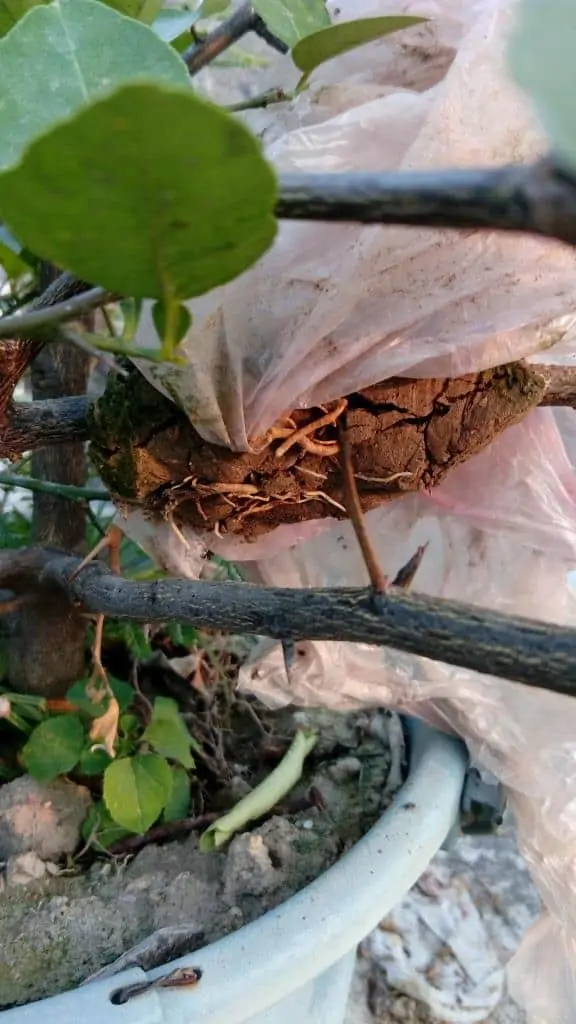
#7: Check for root growth after 5-7 weeks
New root growth can be easily seen through transparent plastic wrapping after 7 weeks. Air layering covered with dark wrapping should not be disturbed at this stage. You cannot check through the opaque wrapping. So please wait for few more weeks.
#8: Detach the Air layered Branch after 10-12 weeks
Your new lemon plant should be ready to detach in 10-12 weeks. I personally prefer to wait for couple more weeks to make sure everything is fine.
Use a pruner or a sharp blade to cut the branch off the lemon tree. Sometimes a blade is more convenient and effective for this purpose as the bench can be really hard to cut.
Make a clean sharp cut at 90Degree just 1 or 2 inches below the air layered portion. Don’t open the wrapping before detaching the layered lemon branch. It may damage the small root ball. So be careful.

#9: Transplant the New Lemon Tree
Transplant the new lemon plant in a small 6-8 inch grow bag or pot. Place the plant in semi-shade for couple more weeks. wait for at least 10-15 days before moving the lemon plant outside.
Meanwhile water the plant only once or twice every week as required. Let the topsoil dry before the next watering spell. You can only feed the plant once with mild liquid fertilizer during this time. Spraying the lemon plant with micro-nutrient and Epsom salt is the best option for faster growth.
#10: Repot the lemon or Lime Plant to Bigger Container
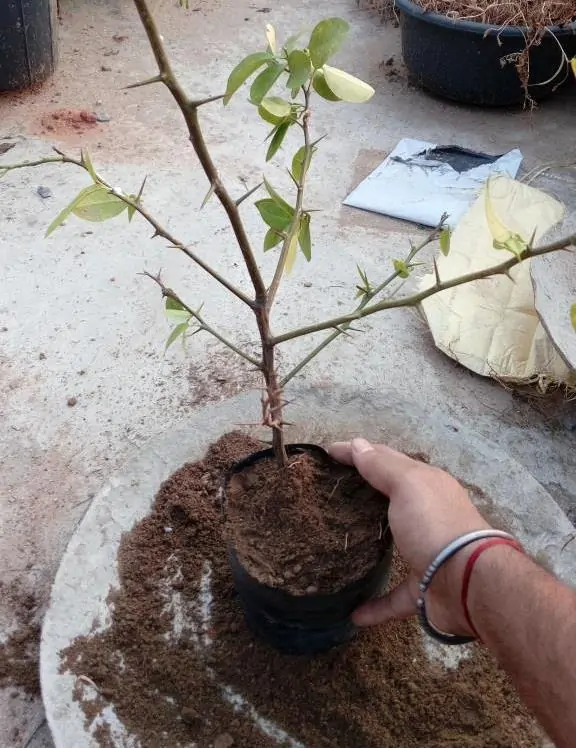
You can re-pot or transplant the air-layered lemon plant to a bigger container after 15-20 days. A smaller pot or container allows the plant to develop a dense root system in a confined isolated space. It will increase the viability of the new lemon plant.
A well-adapted lemon or lime plant must be grown in a 14-18 inch pot or 15-20 gallon grow bag. Lemon is a perennial fruiting plant. so a solid container or open garden is better than any soft grow bag. You can directly place the lemon or lime plant in a sunny spot in your garden.
Check out this before leaving: How to grow Hibiscus by Air Layering? Easy Propagation
Final words
I hope you can now grow your own lemon or lime tree by air layering. Once your plant is ready, keep it in full sun. Water regularly and never let the soil become soggy. Feed the lemon plant with phosphorus and potassium-rich fertilizer. Use NPK 19:19:19 with seaweed liquid fertilizer and Epsom salt for faster growth and bigger fruits.
Keep reading Keep Gardening!

